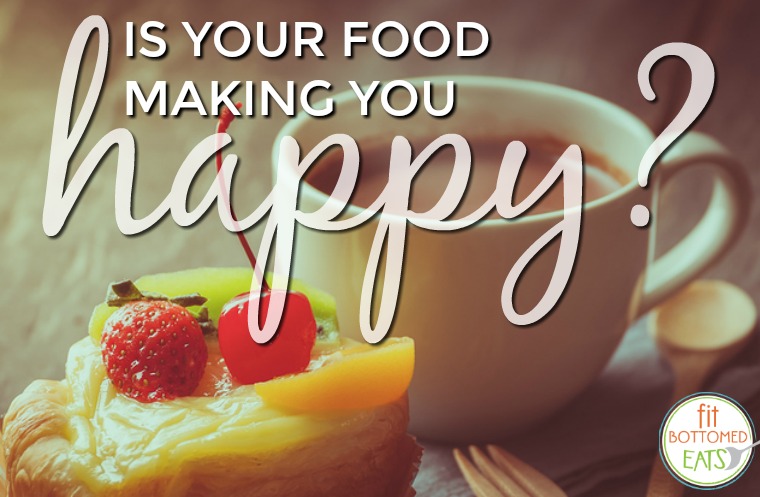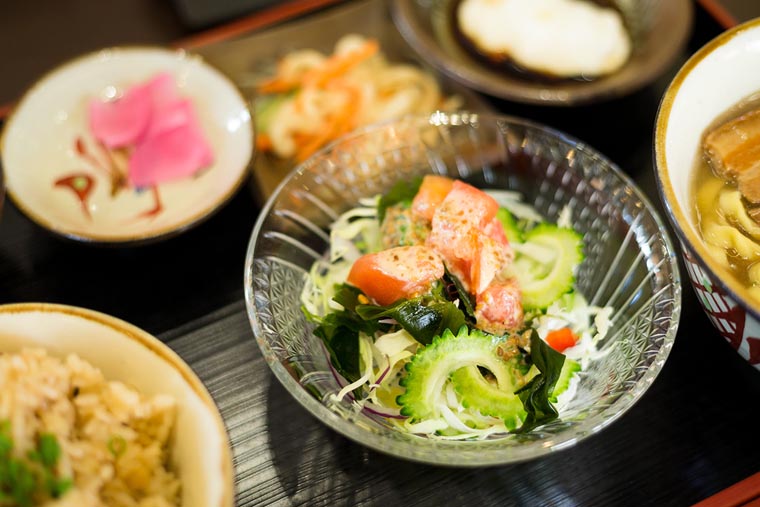Is Your Food Making You Happy?

Food is a powerful thing, and today’s guest post from Victoria Vass of food-near.com delves into just how much of an impact the food we eat has — or doesn’t have — on our overall happiness.
We all know that some places in the world are considered “happier” than others. If a beautiful tropical island pops into your mind as an example of a happy place, you’re not alone. But what if the location is only part of the reason for the mood boost? What if food plays a role?
Finding a Happy Place: Okinawa
If you haven’t seen Happy yet, look it up. It investigates what exactly it is in life that makes us happy, and one of the places it visits is the island of Okinawa in Japan. Okinawa has a subtropical climate, and an unusually high number of centenarians — 34 out of every 100,000 people to be exact. And it just so happens that these old people are very healthy as well as very happy.
The Okinawa Diet
The Okinawan diet has been studied in depth by scientists looking for the secrets of eternal youth. Traditionally the Okinawan population got only about 3 percent of their daily calories from dairy and meat. Okinawans ate seven portions of vegetables (rarely fruit) a day and one or two portions of grains. They consumed tofu or soy twice a day and fish at least three times a week. On special occasions pork would be eaten, but the way it was cooked ensured that most of the fat had been removed.
After the 1950s the Okinawan diet became more like the Western diet. Meat, poultry, and egg consumption increased by more than seven times, and by the 1970s, Okinawans were eating 200 calories more than they needed every day (compared to 400 calories extra consumed in the USA at the time).
With the increasingly Western diet came increasingly Western diseases. Colon, breast and lung cancers doubled in Okinawa. But the people were still happy.
If their changing diet has made them less healthy, but not less happy, what has stayed the same?
What Makes Okinawa Happy?
Okinawans value a sense of community. They nurture community relationships and value compassionate acts. They have groups of friends who take vows to support each other through life’s ups and downs, and they keep their promise. Of course, they also live in a beautiful place, so maybe the warm weather is part of the equation. So, while food might play part of a role in their happiness (because, after all, food and community often go hand in hand), there’s definitely more to it than that.
Europe’s Happy Place: Denmark
Well, the World Happiness Report 2016 places the country of Denmark as currently the happiest place in the world. And it’s not because of the weather! Danish people have to contend with short days (seven hours of light in winter) and average temperatures of 1.5 degrees C in winter to 17 degrees C in summer. Far from a tropical paradise like Okinawa.
So, do the Danish eat a healthy diet that could be responsible for their happiness? The short answer is no. The Danish diet usually consists of three meals a day. The midday meal is likely to be an open sandwich, eaten cold, and Danish families eat a hot meal together in the evening.
The Danish Diet
Meat features heavily in Danish cuisine. Sandwiches might be made with liver pate, smoked eel, salted beef, roast pork or meat jelly. Shrimps, smoked salmon, plaice and halibut may all be served as part of a cold buffet. The evening meal may be seafood like herring, eel, cod or shrimp or it could be a meat dish. Pork meatballs, calf hearts in cream sauce, sausage and liver, are all popular traditional dishes. A very different diet than the Okinawans follow.
The Danish have the highest rate of cancer per capita — 338.1 people out of every 100,000 in Denmark suffer from cancer. This compares to 318 per 100,000 in the USA and only 217.1 per 100,000 in Japan. It appears that health might not influence happiness as much as one might expect.
What Makes Danes Happy?
So, it’s not the diet, and it’s not the weather. What do these two happy places have in common? Well, the Danish have an interesting concept called hygge, and it has similarities to the Okinawan focus on companionship and compassion. There is no direct English translation for hygge, but it means something like comfort, warmth and intimacy.
Meik Wiking, author of The Little Book of Hygge, explains that choosing a Danish pastry and hot chocolate for breakfast are expressions of hygge. The choosing is an act of self-acceptance and self-care. Hygge also puts a lot of emphasis on spending quality time with those you love — a concept which sounds very similar to the Okinawans focus on companionship, care and support.
Happy is What You Make It
Perhaps it is not what we eat then that makes us happy, but how we eat it — and with whom we sit down to dine. Gabriel Cousens, a medical doctor and holistic health practitioner, urges us to bless our food before we eat it. He believes that this will make the food healthier for us, and allow our bodies to take the maximum value from it.
Experiments have proved that what we think about food can change the way our bodies react to it. Blessing food may act as a way of changing our thoughts about the food we are about to eat, therefore maximizing its benefits. Perhaps the tradition of saying grace we see in most religions is based on some ancient wisdom that we have all but forgotten? It would appear that to get the most from food you have to believe that it is good for you.
Does food have the power to make us happy? It certainly appears that it has the power to make us healthy, and not many of us would be disappointed with that. But it also looks as though how we think about our food can impact our happiness.
If we indulge ourselves a little, but do it from a place of self-care and kindness, without feeling guilty, we invoke the power of hygge. Choose a place to eat and invite the people you love to share in the occasion, and you tap into the power of caring and support that both the Danish and Okinawans are well aware of. And if you add in plenty of healthy vegetables and seafood you have covered all the bases. Food can make you happy, especially when eaten in good company.
So, let’s hear it. Does your food make you happy? —Victoria


Comments
The Copenhagen website dedicated to Danish tradition states Liverpostej (liver pate…their national dish) is the Danes most popular and favorite spreading on their open face sandwiches, and is the FIRST CHOICE (their emphasis) when you say Smorrebrod (open face sourdough rye sandwiches). Considering that liver…of many kinds…is THE healthiest food we can eat (contains THE largest amount of the full spectrum of B vits, the full spectrum of amino acids, and great sources of bioavailable vit A and Iron). Combine this with the extremely nourishing other meats that they consume, traditionally and today, I think we CAN conclude that it is their diet that makes them the happiest and healthiest people in the world. B vitamins do MANY critical things in the body, and making us happy is one of the biggest! Makes sense, doesn’t it? ?
http://www.copenhagenet.dk/CPH-Map/CPH-Recipes-12-10-Leverposte-Rugbroedj.asp
Comments are closed.